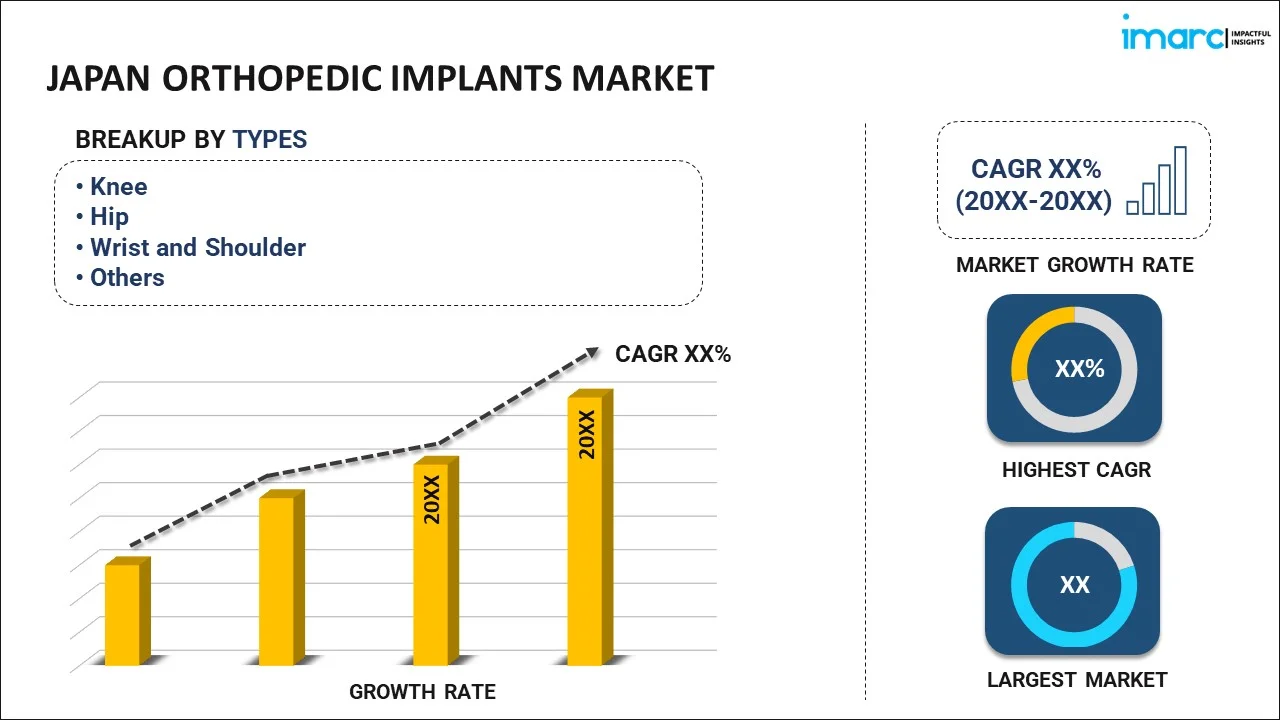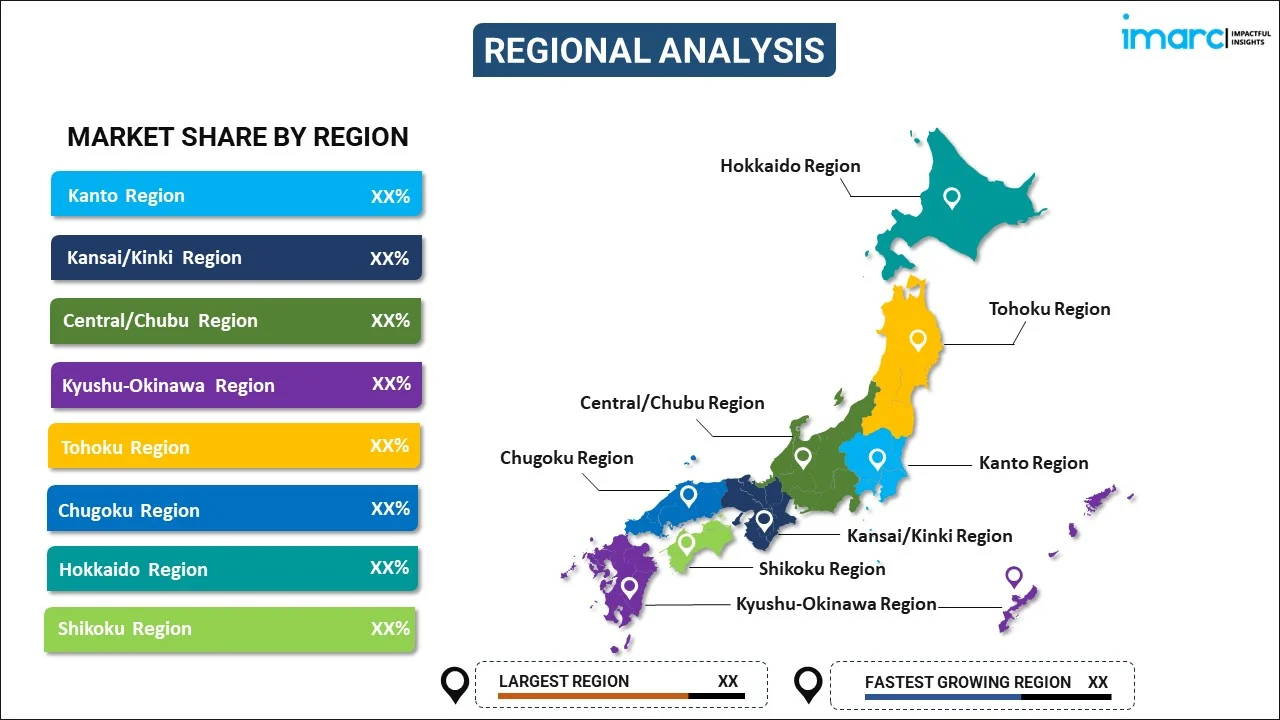
Japan Orthopedic Implants Market Report by Type (Knee, Hip, Wrist and Shoulder, Dental, Spinal, Ankle, and Others), Product (Reconstructive Joint Replacements, Spinal Implant, Dental Implants, Trauma, Orthobiologics, and Others), Biomaterial (Metallic Biomaterials, Ceramic Biomaterials, Polymeric Biomaterials, and Others), End User (Hospitals, Orthopedic Clinics, Ambulatory Surgical Centers, and Others), and Region 2025-2033
Market Overview:
Japan orthopedic implants market size reached USD 2.6 Billion in 2024. Looking forward, IMARC Group expects the market to reach USD 5.0 Billion by 2033, exhibiting a growth rate (CAGR) of 6.7% during 2025-2033. The market is being driven by several significant factors, including substantial progress in orthopedic implant materials and surgical methods and improved healthcare infrastructures.
|
Report Attribute
|
Key Statistics
|
|---|---|
|
Base Year
|
2024 |
|
Forecast Years
|
2025-2033
|
|
Historical Years
|
2019-2024
|
| Market Size in 2024 | USD 2.6 Billion |
| Market Forecast in 2033 | USD 5.0 Billion |
| Market Growth Rate (2025-2033) | 6.7% |
Orthopedic implants are specialized medical devices crafted to address musculoskeletal ailments and injuries. These implants possess essential attributes such as biocompatibility, resilience, and compatibility with the human body. Typically fabricated from materials like titanium, stainless steel, or medical-grade polymers, they ensure prolonged stability within the body. Orthopedic implants encompass a diverse array of designs, encompassing joint replacements like hip and knee prostheses, as well as plates, screws, and rods for fracture fixation, along with spinal implants for managing spinal disorders. Their primary purpose lies in reinstating mobility, alleviating discomfort, and enhancing the overall quality of life for individuals enduring orthopedic ailments, fractures, or degenerative joint conditions.
Japan Orthopedic Implants Market Trends:
The orthopedic implants market in Japan is experiencing significant growth, propelled by several key factors. The country's aging population is a major driver, as the elderly are more susceptible to musculoskeletal conditions and joint-related issues, leading to a higher demand for orthopedic implants. Japan's commitment to technological advancement and innovation in medical devices has resulted in substantial progress in orthopedic implant materials, designs, and surgical techniques. This has not only improved the overall quality of orthopedic care but has also contributed to the growth of the market. Sedentary lifestyles and the rising prevalence of obesity in Japan have led to an increase in orthopedic conditions, such as osteoarthritis and degenerative joint diseases, further boosting the demand for orthopedic implants. Additionally, the country's robust healthcare infrastructure and increased access to orthopedic care have made these implants more readily available to patients, driving market growth. The orthopedic implants used in Japan encompass a wide range of designs, including joint replacements like hip and knee prostheses, fixation devices like plates, screws, and rods for fractures, and spinal implants for addressing spinal disorders. As Japan continues to invest in healthcare and aging-related issues, the orthopedic implants market is expected to flourish, offering advanced solutions for musculoskeletal health.
Japan Orthopedic Implants Market Segmentation:
IMARC Group provides an analysis of the key trends in each segment of the market, along with forecasts at the country level for 2025-2033. Our report has categorized the market based on type, product, biomaterial, and end user.
Type Insights:

- Knee
- Hip
- Wrist and Shoulder
- Dental
- Spine
- Ankle
- Others
The report has provided a detailed breakup and analysis of the market based on the type. This includes knee, hip, wrist and shoulder, dental, spine, ankle, and others.
Product Insights:
- Reconstructive Joint Replacements
- Knee Replacement Implants
- Hip Replacement Implants
- Extremities
- Spinal Implant
- Spinal Fusion Implant
- Vertebral Compression Fracture (VCF) Devices
- Motion Preservation Devices/Non-Fusion Devices
- Dental Implants
- Root Form Dental Implants
- Plate Form Dental Implants
- Trauma
- Orthobiologics
- Demineralized Bone Matrix (DBM)
- Allograft
- Bone Morphogenetic Protein (BMP)
- Viscosupplementation Products
- Synthetic Bone Substitutes
- Others
- Others
A detailed breakup and analysis of the market based on the product have also been provided in the report. This includes reconstructive joint replacements (knee replacement implants, hip replacement implants, and extremities), spinal implant (spinal fusion implant, vertebral compression fracture (VCF) Devices, and motion preservation devices/non-fusion devices), dental implants (root form dental implants and plate form dental implants), trauma, orthobiologics (demineralized bone matrix (DBM), allograft, bone morphogenetic protein (BMP), viscosupplementation products, synthetic bone substitutes, and others), and others.
Biomaterial Insights:
- Metallic Biomaterials
- Stainless Steel
- Titanium Alloy
- Cobalt Alloy
- Others
- Ceramic Biomaterials
- Polymeric Biomaterials
- Others
The report has provided a detailed breakup and analysis of the market based on the biomaterial. This includes metallic biomaterials (stainless steel, titanium alloy, cobalt alloy, and others), ceramic biomaterials, polymeric biomaterials, and others.
End User Insights:
- Hospitals
- Orthopedic Clinics
- Ambulatory Surgical Centers
- Others
A detailed breakup and analysis of the market based on the end user have also been provided in the report. This includes hospitals, orthopedic clinics, ambulatory surgical centers, and others.
Regional Insights:

- Kanto Region
- Kansai/Kinki Region
- Central/ Chubu Region
- Kyushu-Okinawa Region
- Tohoku Region
- Chugoku Region
- Hokkaido Region
- Shikoku Region
The report has also provided a comprehensive analysis of all the major regional markets, which include Kanto Region, Kansai/Kinki Region, Central/ Chubu Region, Kyushu-Okinawa Region, Tohoku Region, Chugoku Region, Hokkaido Region, and Shikoku Region.
Competitive Landscape:
The market research report has also provided a comprehensive analysis of the competitive landscape. Competitive analysis such as market structure, key player positioning, top winning strategies, competitive dashboard, and company evaluation quadrant has been covered in the report. Also, detailed profiles of all major companies have been provided.
Japan Orthopedic Implants Market Report Coverage:
| Report Features | Details |
|---|---|
| Base Year of the Analysis | 2024 |
| Historical Period | 2019-2024 |
| Forecast Period | 2025-2033 |
| Units | Billion USD |
| Scope of the Report | Exploration of Historical and Forecast Trends, Industry Catalysts and Challenges, Segment-Wise Historical and Predictive Market Assessment:
|
| Types Covered | Knee, Hip, Wrist and Shoulder, Dental, Spinal, Ankle, Others |
| Products Covered |
|
| Biomaterials Covered |
|
| End Users Covered | Hospitals, Orthopedic Clinics, Ambulatory Surgical Centers, Others |
| Regions Covered | Kanto Region, Kansai/Kinki Region, Central/ Chubu Region, Kyushu-Okinawa Region, Tohoku Region, Chugoku Region, Hokkaido Region, Shikoku Region |
| Customization Scope | 10% Free Customization |
| Post-Sale Analyst Support | 10-12 Weeks |
| Delivery Format | PDF and Excel through Email (We can also provide the editable version of the report in PPT/Word format on special request) |
Key Questions Answered in This Report:
- How has the Japan orthopedic implants market performed so far and how will it perform in the coming years?
- What has been the impact of COVID-19 on the Japan orthopedic implants market?
- What is the breakup of the Japan orthopedic implants market on the basis of type?
- What is the breakup of the Japan orthopedic implants market on the basis of product?
- What is the breakup of the Japan orthopedic implants market on the basis of biomaterial?
- What is the breakup of the Japan orthopedic implants market on the basis of end user?
- What are the various stages in the value chain of the Japan orthopedic implants market?
- What are the key driving factors and challenges in the Japan orthopedic implants?
- What is the structure of the Japan orthopedic implants market and who are the key players?
- What is the degree of competition in the Japan orthopedic implants market?
Key Benefits for Stakeholders:
- IMARC’s industry report offers a comprehensive quantitative analysis of various market segments, historical and current market trends, market forecasts, and dynamics of the Japan orthopedic implants market from 2019-2033.
- The research report provides the latest information on the market drivers, challenges, and opportunities in the Japan orthopedic implants market.
- Porter's five forces analysis assist stakeholders in assessing the impact of new entrants, competitive rivalry, supplier power, buyer power, and the threat of substitution. It helps stakeholders to analyze the level of competition within the Japan orthopedic implants industry and its attractiveness.
- Competitive landscape allows stakeholders to understand their competitive environment and provides an insight into the current positions of key players in the market.
Need more help?
- Speak to our experienced analysts for insights on the current market scenarios.
- Include additional segments and countries to customize the report as per your requirement.
- Gain an unparalleled competitive advantage in your domain by understanding how to utilize the report and positively impacting your operations and revenue.
- For further assistance, please connect with our analysts.
 Inquire Before Buying
Inquire Before Buying
 Speak to an Analyst
Speak to an Analyst
 Request Brochure
Request Brochure
 Request Customization
Request Customization




.webp)




.webp)












